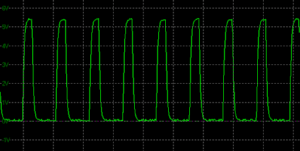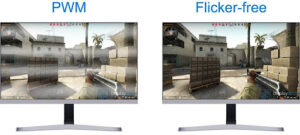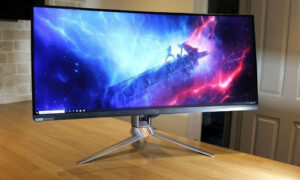What is flicker-free technology and PWM?

 If you are looking for the most efficient monitor then there are some factors that you need to consider such as flicker-free technology and PWM. First, you should know the terms which affect the running so this is the reason you need to know in brief detail about what is flicker-free technology and PWM.
If you are looking for the most efficient monitor then there are some factors that you need to consider such as flicker-free technology and PWM. First, you should know the terms which affect the running so this is the reason you need to know in brief detail about what is flicker-free technology and PWM.
Flicker-free Technology
Flicker-free technology refers to a monitor that does not utilize PWM or Pulse-Width Modulation. It basically reduces a monitor’s brightness setting. It is also known as Flicker-less and Anti-flicker.
In contrast, the PWM technique known as the immediate turning on and off the backlight along with its burning or shining unsteadily; wavering frequency is visible to the human eyes. There are several effects of this also such as eye strain and headache attacks.
The videos which run at increased refresh rates are considered to be flicker-free. To not make things complicated, flickers basically are those monitors which take more time to start the whole screen. It can highly affect your eyes if the flicker of a display is greater. So by this, we can conclude that the monitors which have greater flicker are more efficient than those which have lower flicker rates

PMW or Pulse-Width Modulation
PWM, also known as pulse-width modulation, can be found in high brightness at the laptop screen. The brightness level should be 99% or lower than that. These monitors have a very vast effect on eyes and it also causes severe headaches as well.
The PWM is not necessarily seen only in LCD monitor brightness levels but can also be seen most highly under controlled modern monitors. So this concludes that yes you should be concerned about PWM and flicker-free can also exhibit it

The newly introduced latest monitors do not possess flickering effects. They usually work by utilizing direct current modifications which will help in controlling the brightness settings, which provide a continuous stream of light across all brightness levels.
There are so many monitors that are advertised as flicker-free, but in reality, most are not. Display monitors that use PWM introduce flicker at lower brightness levels (lower than 20% to 30%, sometimes below 50%). This is a significant concern for individuals who prefer lower brightness levels, whether in a dimly lit environment or when the monitor luminance is intense, even below 50%.
It is seen that some of the completely flicker-free monitors are devoid of this information in their product specifications. Instead, most monitor evaluations provide information on whether the products utilize PWM to control the brightness or not.
To keep things simple, flicker is the time taken by a display monitor to reproduce the complete desktop screen for the user. It is to be noted that if the flicker of the screen is high then it affects the vision of the user. It is found that in essence monitors which have higher flicker rates are better to use compared to the monitors which have lower flicker rates.
Benefits of Using Flicker-free Displays
There are several benefits of using Flicker-free monitors such as it causes very less strain in eyes which makes it very suitable for those who use their PC for a long period of time. They usually get headaches if they look at the screen for a long period of time. The local monitors use CCFL tubes as backlights, and these tubes show flickering because this is the way they work.
While searching for the best monitors in the market, you might have come across certain terms such as flicker-free technology and PWM. You should always know what these technologies are and how the presence or absence of these features may affect the performance of your monitor.
So, let’s begin by understanding what flicker-free technology stands for. It refers to those monitors which do not utilize PWM or Pulse-Width Modulation to reduce the brightness of the screen.
Again, on the other hand, the PWM method refers to the quick turning on and turning off of the backlight, with the frequency of flickering naked to the human eye. PWM causes strain on the eyes, headaches, and blurred vision.
So, the good news for the buyers is that the latest models of monitors are generally flicker-free, they use modulation of current to control the brightness and hence deliver a constant of light across all brightness levels.
Generally, conventional LCD monitors operate at a 60 Hz of refresh rate.
Display monitors are generally fitted with LED backlights which are actually meant to reduce the problem that is the act as the remedy. However, the LED typically turns off and on and either makes the screen brighter or dimmer.
The LEDs also pulsed at a faster or slower rate and thus creating a flickering effect on a person’s eyes and thus causing headache and eye strain.
So now the question arises whether you as a buyer should be concerned about PWM or whether flicker-free PWM is worth it.
To answer your question in the simplest way, yes PWM is used not only for LCD monitor brightness settings but also in forms of finite control access over modern electronic gadgets. The speed of the fans is also controlled by implementing PWM. Newer smartphone technologies also implement PEM but at a smaller rate.
Why does PWM cause nausea, headache, and eye strain?
Low PWM frequencies on a display monitor are unpleasant by our own standards and lower results in headache and nausea due to the constant flickering of the screen backlight at low frequencies.
No noticeable frequencies may cause rapid dilation and contraction of the eye pupils and hence may result in several vision problems and headaches.
On the other hand, high frequencies cause less strain on the eyes due to the flickering fusion threshold of the human eye. This feature allows the flickering effect at a higher frequency to reach up to you as if it was on the entire time creating an illusion for the eyes and does not make it feel uncomfortable.
When the frequency is low unwanted symptoms appear and cause problems for the user and may result in other severe problems like vision problems.
Thus the user while buying the monitors must also consider the issues which not only makes the work easier but also makes his/her eyes comfortable to view and work with screen light.
Conclusion
We hope that with the invitation one can easily resolve the concern for display that uses the flicker free and PWM technology. In the future manufacturers may set up their game and will feature in the laptop display which is generally present in the monitor. To avoid eye fatigue, nausea and headache. We can adjust the brightness according to our comfort. This will increase our productivity .